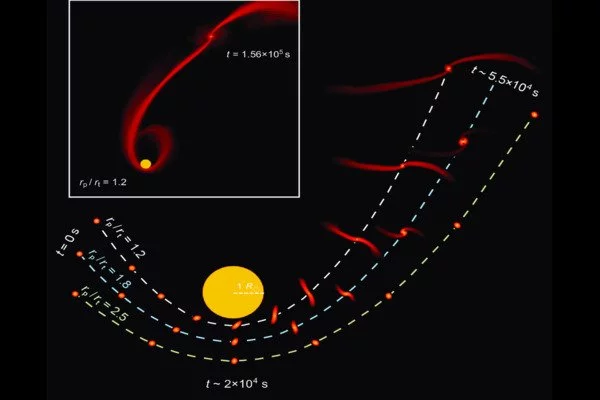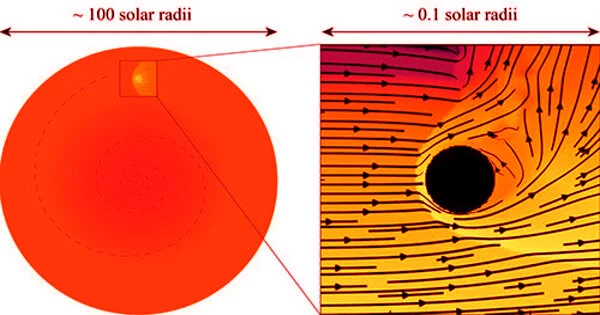Engulfment of substellar bodies (SBs) such as brown dwarfs and planets has been proposed as an explanation for the presence of SBs orbiting subdwarfs and white dwarfs, rapidly rotating giants, and lithium-rich giants. We run three-dimensional hydrodynamic simulations of the flow around an SB engulfed in a stellar envelope.
A new study using hydrodynamic simulations reveals the forces at work on a planet as it is swallowed up by an expanding star. The findings show that interactions between a substellar body (a planet or brown dwarf) and the hot gas in a sun-like star’s outer envelope can result in a variety of outcomes depending on the size of the engulfed object and the stage of the star’s evolution. The dynamics and possible outcomes of planetary engulfment are poorly understood, but it is thought to be a relatively common fate for planetary systems.
When the hydrogen fuel in our sun’s core runs out in 5 billion years, it will expand to become a red giant, engulfing the inner planets. The dynamics and potential outcomes of planetary engulfment are unknown, but it is thought to be a common fate for planetary systems.
A new study using hydrodynamic simulations reveals the forces at work on a planet as it is swallowed up by an expanding star. The findings show that interactions between a substellar body (a planet or brown dwarf) and the hot gas in a sun-like star’s outer envelope can result in a variety of outcomes depending on the size of the engulfed object and the stage of the star’s evolution.
Evolved stars can be hundreds or even thousands of times larger than their planets, and this disparity of scales makes it difficult to perform simulations that accurately model the physical processes occurring at each scale.
Ricardo Yarza
Lead author Ricardo Yarza at the University of California, Santa Cruz, will present the new findings, at the 240th meeting of the American Astronomical Society (AAS) in Pasadena.
“Evolved stars can be hundreds or even thousands of times larger than their planets, and this disparity of scales makes it difficult to perform simulations that accurately model the physical processes occurring at each scale,” said Yarza, a graduate student in astronomy and astrophysics at UCSC. “Instead, we simulate a small section of the star centered on the planet to understand the flow around the planet and measure the drag forces acting on it.”
The findings could help explain recent observations of planets and brown dwarfs orbiting stellar remnants such as white dwarfs and subdwarfs. Previous research has suggested that these systems are the end result of a planetary engulfment process that involves the shrinking of the engulfed body’s orbit and the ejection of the star’s outer layers.
“As the planet moves inside the star, drag forces transfer energy from the planet to the star, and the stellar envelope can become unbound if the transferred energy exceeds its binding energy,” Yarza explained.

According to Yarza and his colleagues’ calculations, no substellar bodies smaller than about 100 times the mass of Jupiter can eject the envelope of a sun-like star before it has expanded to about 10 times the radius of the sun. However, at later stages of stellar evolution and expansion, the stellar envelope could be ejected by an object as small as ten times the mass of Jupiter, shrinking its orbit by several orders of magnitude in the process.
The study also discovered that planetary engulfment can increase the luminosity of a sun-like star by several orders of magnitude for up to several thousand years, depending on the mass of the engulfed object and the star’s evolutionary stage.
The framework provided by this study can be incorporated into future work to explore the effect of engulfment on the structure of the star. “Our work can inform simulations of planetary engulfment at the scale of the star by providing an accurate reference picture of the physics at the scale of the planet,” Yarza said.
Exoplanet search programs have now described a wide range of planetary systems. A significant proportion of these systems are likely to be engulfed by the planet as they evolve. “We think it’s fairly common,” Yarza said.
According to Yarza and his colleagues’ calculations, no galaxies less than 100 times smaller than Jupiter can pull out a sun-like star’s envelope before extending it up to ten times in space. However, in the later stages of star formation and expansion, the star envelope could be replaced by something ten times the size of Jupiter, reducing its rotation by several orders of magnitude.





